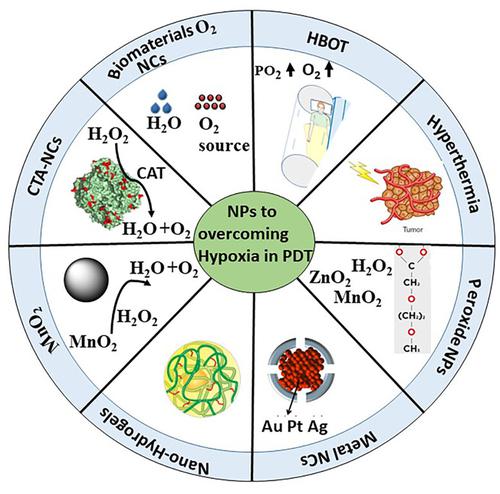当前位置:
X-MOL 学术
›
WIREs Nanomed. Nanobiotechnol.
›
论文详情
Our official English website, www.x-mol.net, welcomes your feedback! (Note: you will need to create a separate account there.)
Nanotechnology-mediated photodynamic therapy: Focus on overcoming tumor hypoxia
WIREs Nanomedicine and Nanobiotechnology ( IF 8.6 ) Pub Date : 2023-12-10 , DOI: 10.1002/wnan.1937 Kave Moloudi 1 , Heidi Abrahamse 1 , Blassan P. George 1
WIREs Nanomedicine and Nanobiotechnology ( IF 8.6 ) Pub Date : 2023-12-10 , DOI: 10.1002/wnan.1937 Kave Moloudi 1 , Heidi Abrahamse 1 , Blassan P. George 1
Affiliation

|
The oxygen level in the tumor is a critical marker that determines response to different treatments. Cancerous cells can adapt to hypoxia and low pH conditions within the tumor microenvironment (TME) to regulate tumor metabolism, proliferation, and promote tumor metastasis as well as angiogenesis, consequently leading to treatment failure and recurrence. In recent years, widespread attempts have been made to overcome tumor hypoxia through different methods, such as hyperbaric oxygen therapy (HBOT), hyperthermia, O2 carriers, artificial hemoglobin, oxygen generator hydrogels, and peroxide materials. While oxygen is found to be an essential agent to improve the treatment response of photodynamic therapy (PDT) and other cancer treatment modalities, the development of hypoxia within the tumor is highly associated with PDT failure. Recently, the use of nanoparticles has been a hot topic for researchers and exploited to overcome hypoxia through Oxygen-generating hydrogels, O2 nanocarriers, and O2-generating nanoparticles. This review aimed to discuss the role of nanotechnology in tumor oxygenation and highlight the challenges, prospective, and recent advances in this area to improve PDT outcomes.
中文翻译:

纳米技术介导的光动力疗法:专注于克服肿瘤缺氧
肿瘤中的氧气水平是决定对不同治疗的反应的关键标志物。癌细胞可以适应肿瘤微环境(TME)内的缺氧和低pH条件,调节肿瘤代谢、增殖,促进肿瘤转移和血管生成,从而导致治疗失败和复发。近年来,人们广泛尝试通过不同的方法来克服肿瘤缺氧,如高压氧治疗(HBOT)、热疗、O 2载体、人工血红蛋白、制氧水凝胶和过氧化物材料。虽然氧气被发现是改善光动力疗法 (PDT) 和其他癌症治疗方式的治疗反应的重要因素,但肿瘤内缺氧的发生与 PDT 失败高度相关。最近,纳米粒子的使用已成为研究人员的热门话题,并通过产氧水凝胶、O 2纳米载体和O 2产生纳米粒子来克服缺氧。本综述旨在讨论纳米技术在肿瘤氧合中的作用,并强调该领域改善 PDT 结果的挑战、前景和最新进展。
更新日期:2023-12-10
中文翻译:

纳米技术介导的光动力疗法:专注于克服肿瘤缺氧
肿瘤中的氧气水平是决定对不同治疗的反应的关键标志物。癌细胞可以适应肿瘤微环境(TME)内的缺氧和低pH条件,调节肿瘤代谢、增殖,促进肿瘤转移和血管生成,从而导致治疗失败和复发。近年来,人们广泛尝试通过不同的方法来克服肿瘤缺氧,如高压氧治疗(HBOT)、热疗、O 2载体、人工血红蛋白、制氧水凝胶和过氧化物材料。虽然氧气被发现是改善光动力疗法 (PDT) 和其他癌症治疗方式的治疗反应的重要因素,但肿瘤内缺氧的发生与 PDT 失败高度相关。最近,纳米粒子的使用已成为研究人员的热门话题,并通过产氧水凝胶、O 2纳米载体和O 2产生纳米粒子来克服缺氧。本综述旨在讨论纳米技术在肿瘤氧合中的作用,并强调该领域改善 PDT 结果的挑战、前景和最新进展。



























 京公网安备 11010802027423号
京公网安备 11010802027423号